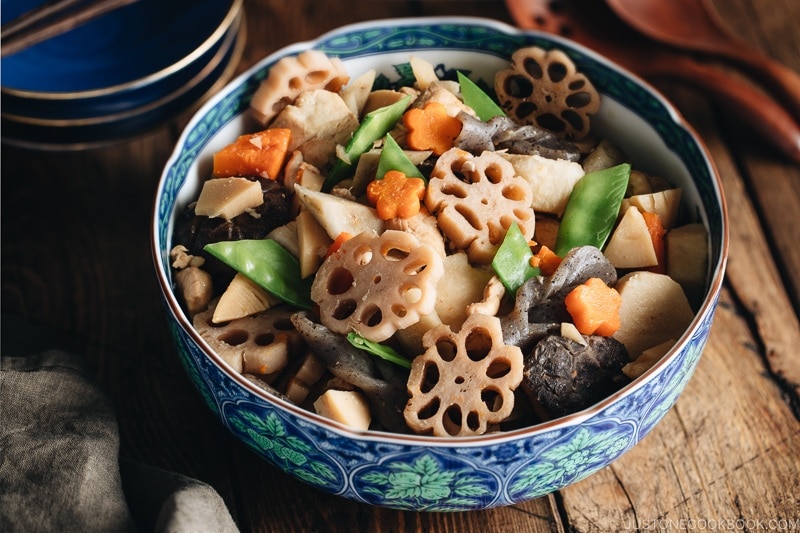
Simmered in a savory dashi based sauce, Nishime is a classic one-pot vegetable stew to serve in Osechi for the Japanese New Years celebration.
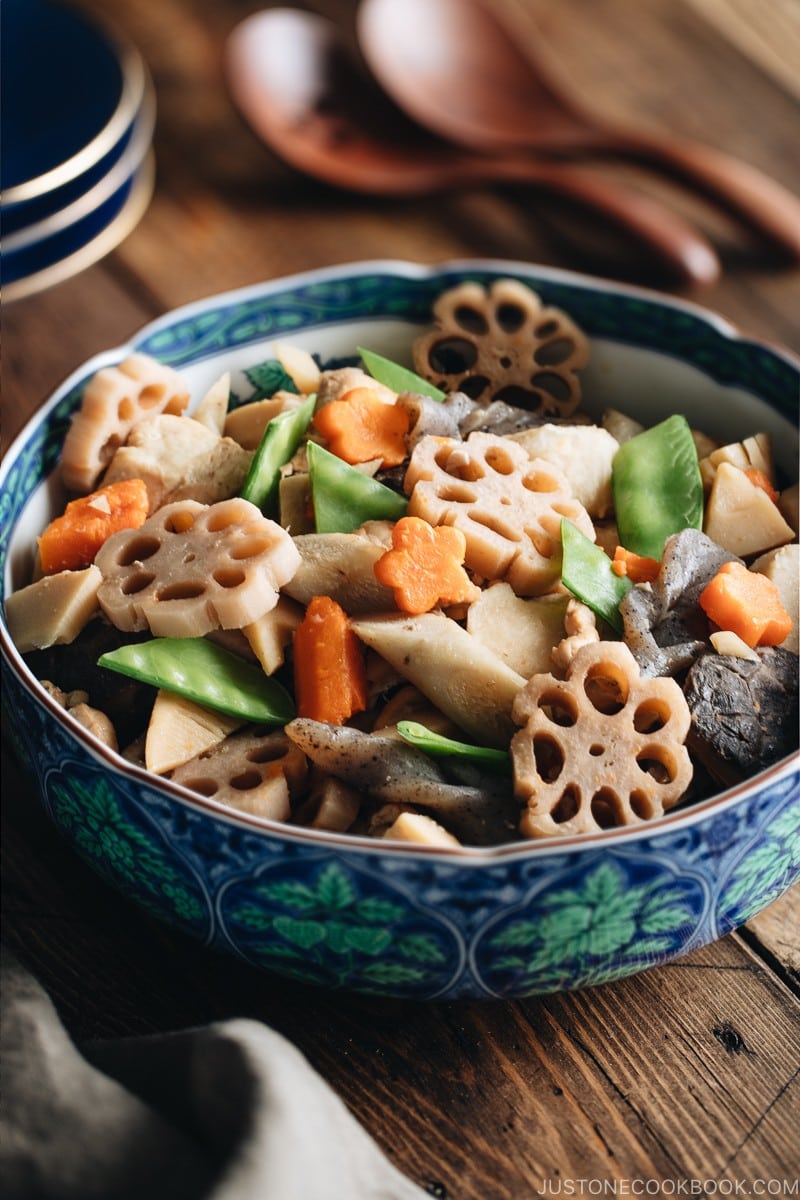
The Osechi (Japanese New Year’s food) menu is about preserving traditional recipes and celebrating the essence of food. Whether it’s for prosperity or good health, every dish plays a role in welcoming the new year. You’ll find simmered dishes such as Nishime (煮しめ) or sometimes called Chikuzenni (筑前煮), being served for its many auspicious significance.
In this one-pot colorful stew, root vegetables and chicken are simmered in dashi broth seasoned with soy sauce, sake, and mirin. I’ve shared my regular stove-top Chikuzenni recipe before, but this year I decided to speed things up by using pressure cooker function of the Instant Pot. It can make a big batch in a short time, perfect for entertaining a big group of family and friends!
Watch How to Make Instant Pot Nishime
Simmered in a savory dashi based sauce, Nishime is a classic one-pot vegetable stew to serve in Osechi for the Japanese New Years celebration.
What is Nishime?
Nishime (煮しめ) is a traditional Japanese vegetable stew sometimes prepared with chicken. The dish is the most popular nimono (煮物), or a simmered dish in English, and a classic representation of Japanese home-cooked meal. It’s often served at special celebratory occasions and Japanese New Years because the ingredients have different meanings for joy, happiness, prosperity, and cleansing.
The stew commonly includes root vegetables, starchy potatoes, konnyaku (konjac), kombu, deep-fried tofu, sometimes chicken, fish cake (chikuwa and kamaboko), and occasionally fish depending on the regions.
The cooking method where you simmer ingredients for a long time to reduce the cooking liquid is called Nishimeru (煮しめる), and shorten to Nishime (煮しめ). Sometimes it’s written as Nishime (煮染め) or Nishime (煮締め), or Onishime with honory “o”.
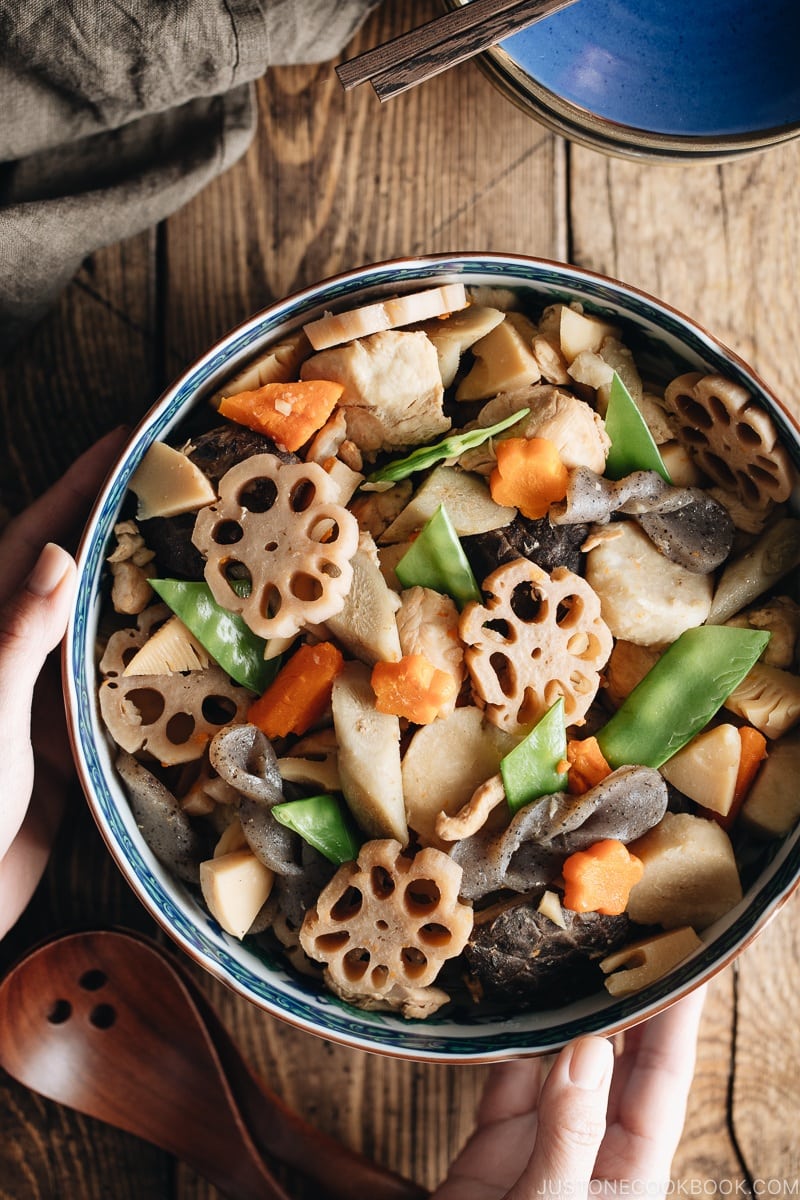
Decorative-Cut Ingredients
As a New Year’s dish, the vegetables and konnyaku are cut into fancy shapes to celebrate the occasion. Whether you want to cut the ingredients with decorative designs or not, it is entirely up to you. I have two reasons why it can be a nice thing:
- Dress up for the New Year. This is the special time we put on fancy clothing and dress up our homes, why not do it for the Osechi too?
- A “wow” factor for this very humble dish, with root vegetables and other low-key ingredients.
Too much work? I agree, especially when you have to make so many other dishes for the New Year. But hey, that’s why I’m introducing the Instant Pot version.
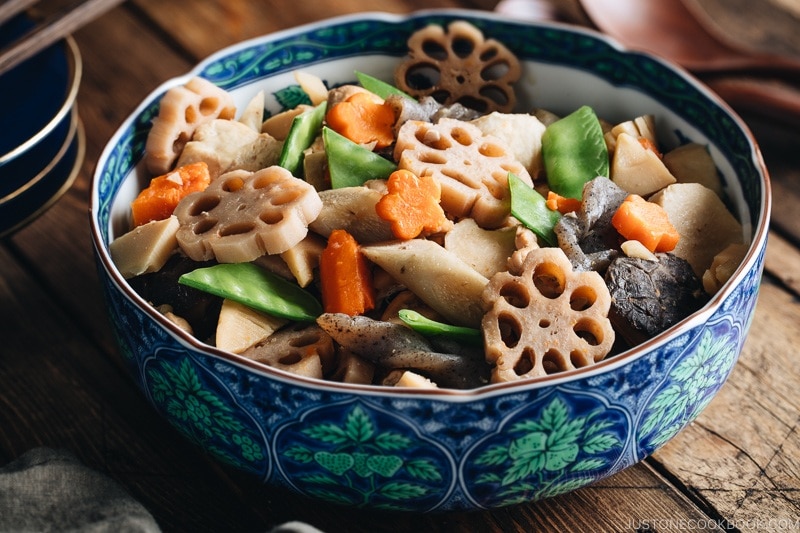
Auspicious Ingredients for Instant Pot Nishime
The following ingredients are included for auspicious reasons:
- Carrot – Welcome spring by shaping carrot into plum (ume) flower.
- Lotus root – The holes of lotus root presents a clear and unobstructed future.
- Burdock root – A skinny, long root that grows straight down into the ground symbolizes stability for house and family.
- Shiitake mushroom – It represents longevity when you cut the edges of the mushroom into a hexagon that resembles a turtle shape.
- Taro – Taro symbolizes fertility or descendants prosperity as you can find a lot of baby taros in one root.
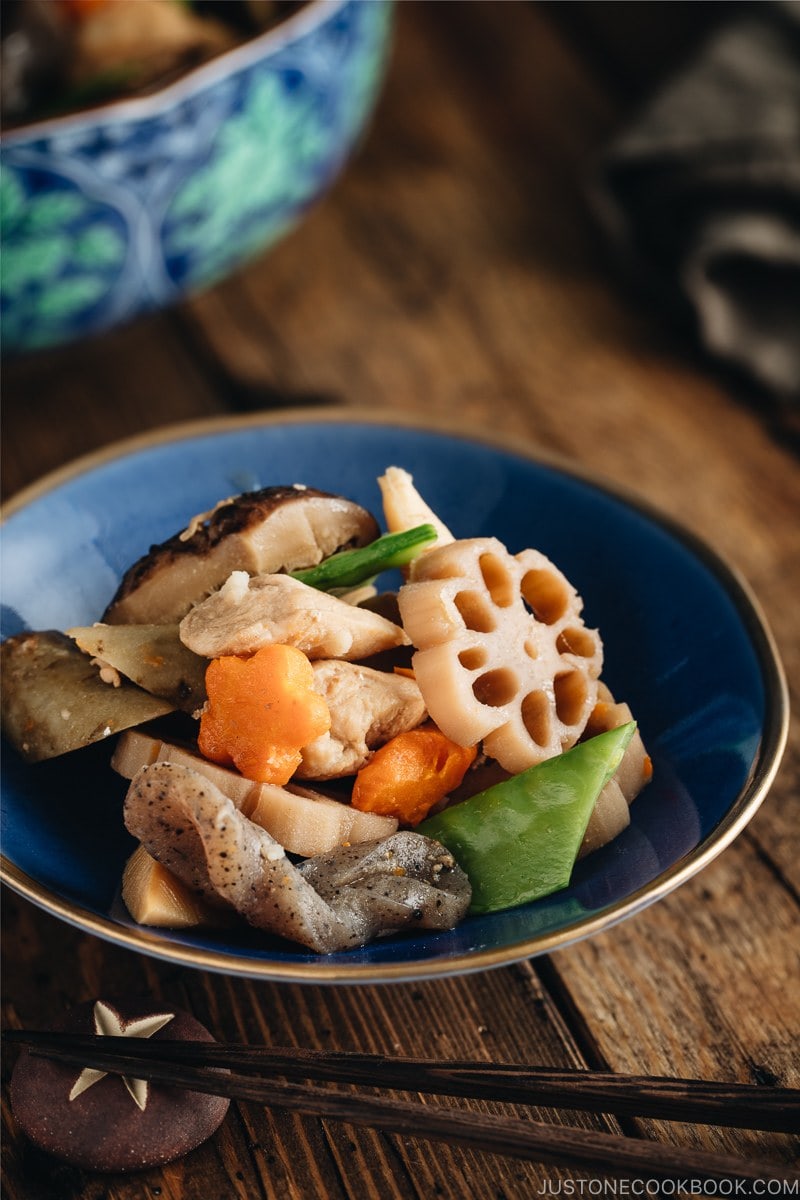
Substituting Difficult-to-Find Japanese Ingredients
Vegetables: Many of the ingredients used in Nishime that can be found in Chinese and/or Korean grocery stores, and sometimes Southeast Asian grocers. If you are lucky, some of the major grocery stores like Whole Foods or local co-ops may carry these unique vegetables too.
Konnyaku (konjac): This, on the other hand, may be difficult to find. But you can skip it as konjac is included more for the texture and auspicious purpose.
Dashi Packet: To show you how quickly you can make dashi, I used dashi packet in this recipe. You can buy a bag of dashi packet from my favorite brand Kayanoya on Amazon (or less-expensive option). I really want to encourage you to ditch the dashi powder and start using dashi packet instead. The flavor of dashi is really important for this dish or any other Japanese cooking.
Dashi from Scratch: Of course, it’s best to make dashi from scratch. It is so simple and takes only half an hour or less to make dashi (or can be faster). You can’t make authentic Japanese food without dashi, so please try your best to make dashi instead of using other stock (unless I mention it).
And may the New Year bring you and your family lots of happiness and new inspirations as you enjoy this Instant Pot Nishime together.

Japanese Ingredient Substitution: If you want to look for substitutes for Japanese condiments and ingredients, click here.
Sign up for the free Just One Cookbook newsletter delivered to your inbox! And stay in touch with me on Facebook, Pinterest, YouTube, and Instagram for all the latest updates.
Instant Pot Nishime

Simmered in a savory dashi based sauce, Nishime is a classic one-pot vegetable stew to serve in Osechi for the Japanese New Years celebration.
For Dashi
- 1 cup water ((240 ml))
- 1 dashi packet
- 5 dried shiitake mushrooms
For Nishime Ingredients
- 10 snow peas
- ½ konnyaku (konjac)
- 1 bamboo shoot
- 1 lotus root (renkon)
- 1 carrot
- 5 satoimo (Japanese taro)
- 1 gobo (burdock root)
- ¾ lb boneless skinless chicken thigh ((340 g) (I used chicken tender today))
- 1 ½ Tbsp sesame oil
Seasonings
- 1 Tbsp sugar
- 2 ½ Tbsp mirin
- 1 Tbsp sake
- 3 Tbsp usukuchi soy sauce (light color) ((or use regular soy sauce))
- ½ tsp kosher salt
- Gather all the ingredients.
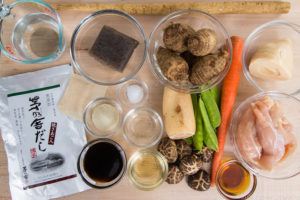
To Make Dashi
-
In a small saucepan, add 1 cup water and 1 dashi packet. Slowly bring to a boil on medium-low heat, while gently shaking the bag a few times to get more flavors. Once boiling, lower the heat and cook for 1 minute. Then turn off the heat.
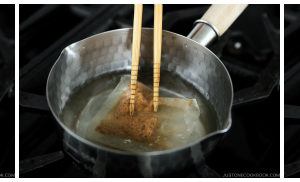
-
Remove the pot from heat and remove the dashi packet. Add the dried shiitake mushrooms to rehydrate for 15 minutes.
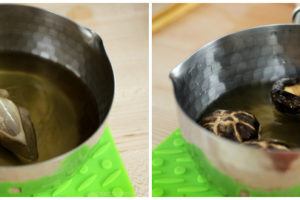
To Prepare Ingredients
-
Remove the tough strings off the snow peas.
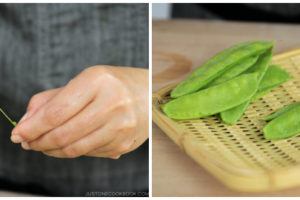
-
Make Tazuna Konnyaku. Slice konnyaku to about 1/8 to 1/4 inch (7-8 mm) thick. At the center of each slice, make a 1 ½ inch slit.
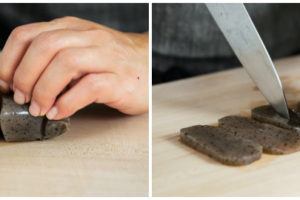
- Put the top or bottom part through the hole. Push it in and pull out both ends.
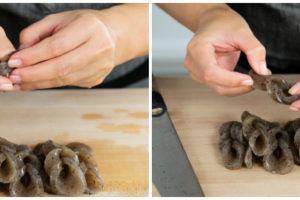
- Boil water in a saucepan over medium-high heat. Add a pinch of salt and blanch the snow peas for 30-60 seconds, until crisp but tender enough to eat. Transfer snow peas to a sieve/plate.
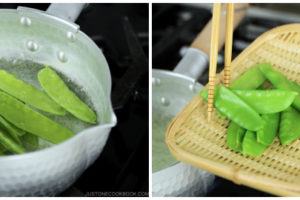
- In the same boiling water, add the konnyaku and cook for 2-3 minutes to remove the smell (which is why you cook after snow peas).
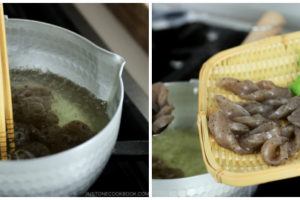
- Cut the bamboo shoot into quarters. Keep the tip into 1 ½ inch length (so it will look pretty), and slice the rest (bottom) of the piece.
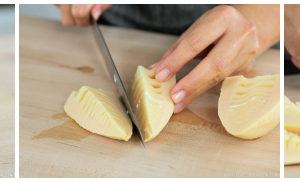
- Peel the lotus root skin and cut in half.
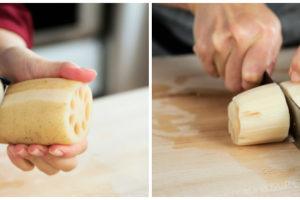
-
[Optional] If you want to make Hana Renkon (Flower Lotus Root), here is the tutorial.
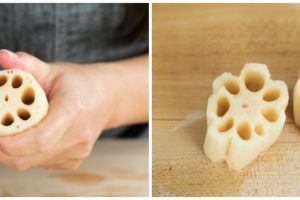
- Slice the lotus root into ¼ inches and soak in water (or 2 cups water + 1 tsp vinegar to make the lotus root whiter).
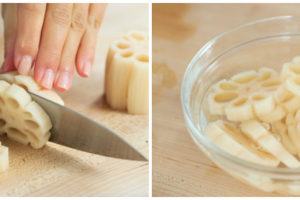
- Peel and cut the carrot using Rangiri Japanese cutting technique. [Optional] If you like the flower shape carrot, then first cut the top 2 inches into ¼ inch slices. And cut the rest of carrot using Rangiri cutting technique.
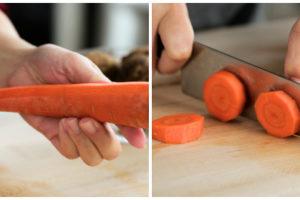
-
[Optional] Cut out the carrot into a flower shape. You can eat the cutout carrot (mince it and use in fried rice or soup).
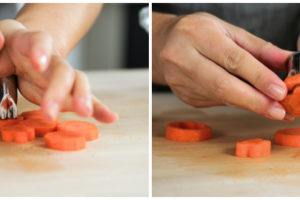
- Peel the taro skin with a sharp knife. It’s very tough, so I don’t recommend using the vegetable peeler. Instead, use a knife to slowly peel the skin. For taro, it’s recommended to peel the skin thick (It’s not considered wasteful to remove skin with more flesh attached).
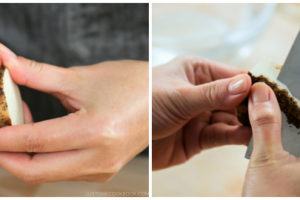
- Cut each taro in half and soak in water to get rid of starch and astringent taste.
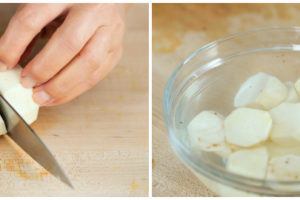
-
Lightly peel the gobo skin with the back of your knife (unlike taro, you want to preserve the flesh as much as possible as the flavor of gobo stay right under the skin). Cut the gobo using Rangiri Japanese cutting technique and soak in water to get rid of starch and astringent taste.
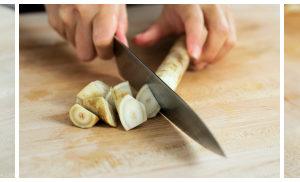
- By now the dried shiitake mushrooms should be soft and hydrated. Squeeze the liquid out from the shiitake mushrooms. And strain the liquid over a fine mesh sieve over a measuring cup. You will need 200 ml (= take away 2 Tbsp from 1 cup).
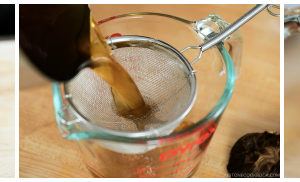
-
Discard the stem of shiitake mushrooms. [Optional] Cut the edges to make into a hexagon, which represents turtle shape for longevity.
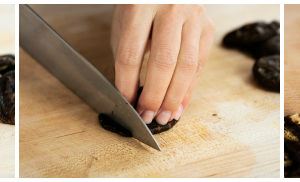
-
Cut the chicken tender using Sogigiri. cutting technique. It creates more surface which allows the chicken to cook faster and absorb more flavors.
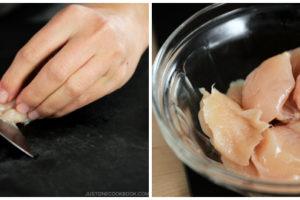
To Cook Ingredients in Instant Pot
- Press the “Sauté” button on your Instant Pot and heat 1 ½ Tbsp sesame oil.
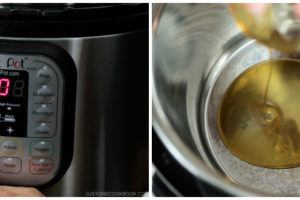
- Add the chicken tender and coat with oil.
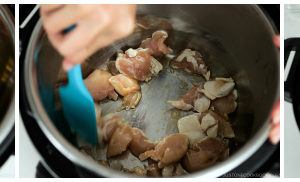
- When the chicken is no longer pink outside, add the lotus root, taro, gobo, and bamboo shoot. Then add the dashi.
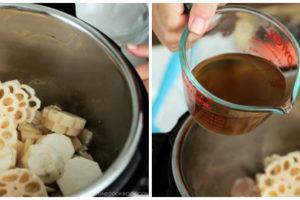
- Add 1 Tbsp sugar, 2 ½ Tbsp mirin, 1 Tbsp sake, 3 Tbsp usukuchi soy sauce (light color), and ½ tsp kosher salt.
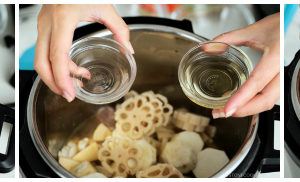
- Mix well with seasonings and ingredients. Add carrot and konnyaku (save the snow pea for garnish).
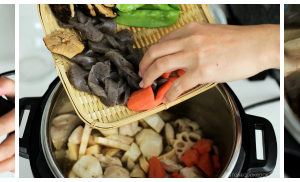
- Press “Cancel” to stop “Saute” mode. Close the lid and set HIGH pressure for 3 minutes.

- Make sure the steam release handle points at “sealing” and not “venting”. The float valve goes up when pressurized.
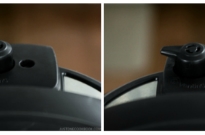
Once Pressure Cooking Is Done…
- When it’s finished cooking, the Instant Pot will switch automatically to the “Keep Warm” mode. Let the pressure release naturally.
-
Open the lid and gently mix the ingredients. Serve individually or in a large bowl. Garnish with snow peas (I cut each diagonally in half).
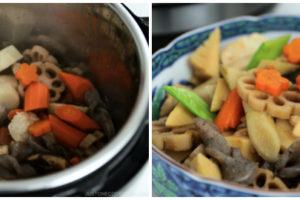
To Store
-
Transfer Nishime in an airtight container and let cool completely before storing in the refrigerator. You can keep in the fridge up to 5 days. Reheat in a pot and serve. The flavor will intensify as time passes. If you plan to serve later on, you may consider reducing the amount of seasoning. Nishime also freezes well. Defrost overnight and reheat in a pot.
Japanese Ingredient Substitution: If you want to look for substitutes for Japanese condiments and ingredients, click here.
Recipe by Namiko Chen of Just One Cookbook. All images and content on this site are copyright protected. Please do not use my images without my permission. If you’d like to share this recipe on your site, please re-write the recipe in your own words and link to this post as the original source. Thank you.
from Merah Hati Cintaku http://bit.ly/2LAg60T
via merahhaticintaku.blogspot.my
No comments:
Post a Comment